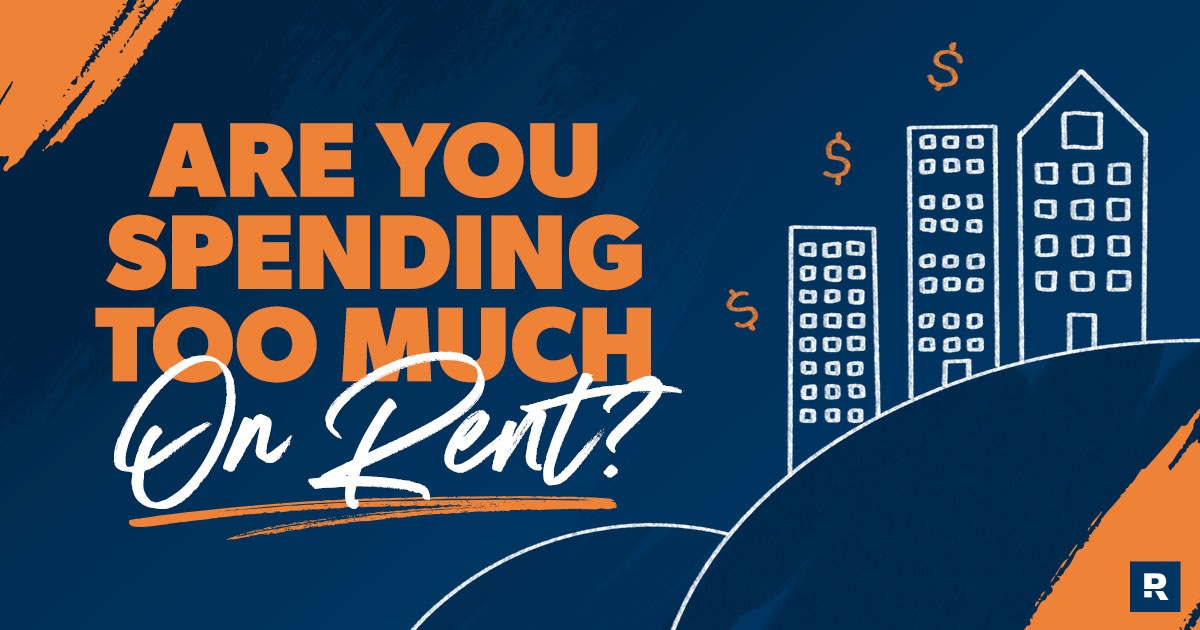
Sometimes, renting is a much better option than buying a house. Yep, it’s true! When you’re just starting out after leaving your parents’ house, working hard to get out of debt, or newly married, renting is a great idea. And renters are definitely in good company—more than 100 million people in America are renters.1
But if you’re planning to start renting a house or apartment, you probably have an important question on your mind: How much rent can I afford? You may even be wondering about that if you’re already renting. So, let’s dig into how much you should spend on rent.
How Much Should You Spend on Rent?
Your rent payment (including renters insurance) should be no more than 25% of your take-home pay. Here’s an example:
- Let’s say you make $56,000 per year.
- Your monthly take-home pay after taxes would be around $3,734.
- If you multiplied that take-home pay by 0.25, you’d wind up with $933.50.
- So, with a $56,000 salary, the most you should spend on rent in a month is $933.50.
Simple, right? Here are some other examples of how much of your income you should spend on rent, based on how much money you take home each month.
|
Income |
Rent You Can Afford |
|
$40,000 |
$710 |
|
$50,000 |
$876 |
|
$60,000 |
$1,040 |
|
$75,000 |
$1,260 |
|
$90,000 |
$1,480 |
We know 25% might seem like a low number to you. After all, there are plenty of people who spend a lot more than that on their housing costs—and some so-called “financial gurus” even teach that it’s okay to spend 30% of your take-home pay on rent. (They call that the “30% rule.”)
But here’s the deal: If you spend more than 25% of your take-home pay on rent, your budget will wind up being really tight. Sure, you’ll still be able to pay for food and put gas in your car, but you won’t have a whole lot left to spend on life’s other necessities (and, no, goat yoga is not a necessity).
Worse, it’ll be really tough to find enough money to get yourself out of debt or, if you’re already debt-free, save up for a down payment on a house. We call that house poor—aka broke. Don’t volunteer to be broke by paying too much for rent.
What About the 50/30/20 Rule?
Some people recommend the 50/30/20 rule (50% for needs, 30% for wants, and 20% for savings) when budgeting for rent. But that way of thinking won’t give you the flexibility or focus you need to accomplish big money goals like saving for a house.
A budget is never one-size-fits-all. Your rent payment will stay the same from month to month, but other expenses aren’t so consistent. Plus, your stage of life will affect how much money you should put toward wants and needs. For example, your budget should definitely change if you decide to start saving for a car, paying off debt, or putting money aside for your kids’ college.
So, avoid the 50/30/20 rule when trying to figure out how much of your income should go toward rent. Instead, keep the 25% rule in mind and make a new, unique budget each month.
Here's A Tip
The best type of budget is a zero-based budget, where your income minus your expenses equals zero. No, you don’t want to spend all the money you make, but you do want every dollar to have a job. Check out our free guide and see what zero-based budgeting can do for you.
What Can I Do to Afford My Monthly Rent?
You may have heard that 25% rule and thought, There’s no way I can keep my rent that low! If you did, don’t worry—there are ways to offset crazy-high rent prices. Here are six tips to help you figure out how to afford rent and keep it from eating away at your budget.
1. Get Roommates
If you’re not making a lot of money (or you just don’t want to pay a boatload for rent each month), it’s time to find a roommate. The idea of living with a roommate may give you some painful flashbacks to college, but you won’t have to step over week-old pizza boxes on the living room floor this time around.
Find expert agents to help you buy or sell a home.
You’re a grown-up now, and you can room with another grown-up. Think of it as like-minded people in the same phase of life wanting to save money by sharing a living space. No lava lamps, Star Wars posters, or Iron Man helmets required.
2. Rent a Room Instead of an Apartment
Believe it or not, a lot of homeowners are looking to rent out a spare bedroom or an unused bonus room. Sure, you might not have free rein to kick off your shoes and put your feet up on the living room table, but you’ll still have your own bedroom and (maybe) bathroom. And if the rent is super cheap—who can complain, really?
3. Increase Your Income
It turns out the answer to “How much rent can I afford?” will be different if you make more money. Up your income and you can afford more, right?
The good news is, there are plenty of ways to increase your income these days, and some of them are actually pretty easy. There are pizzas that need delivering, folks who need to be driven all around town, and leaves that need to be raked. So, what are you waiting for?
4. Find a Cheaper Location
The cost of rent mostly depends on where you live, so if you can’t afford the housing market in the heart of the city, start looking in the suburbs or farther out from the big metro hubs. You might have a longer commute, but the savings for living 30 miles south could be huge.
Want More Expert Real Estate Advice?
Sign up for our newsletter! It’s packed with practical tips to help you tackle the housing market and buy or sell your home with confidence—delivered straight to your inbox twice a month!
5. Get a Higher-Paying Job
Keep in mind that the cost of rent is only going to go in one direction: up. To stay on top of it, your income should be going in the same direction too. If you know you can count on a pay raise each year, great. But the truth is, you might need a higher-paying job altogether to make things work. Get out your budget and see how a higher income would change things.
6. Compare Insurance Rates
We get it—insurance can seem boring and complicated. But you may be overpaying for your coverage, and you could save some serious money by working with an independent agent who can shop rates from multiple insurance providers. Our RamseyTrusted insurance pros fit that bill, and they can help you make the best decision for you and your family.
The Bottom Line
Figuring out how much you should spend on rent is a big key for keeping your money in check. So, keep that 25% rule in mind, and you’ll stay on the right track.
And if rent seems sky-high, don’t sweat it! Remember tricks like snagging roommates, checking out cheaper areas, or even bumping up your income—all of which can make your rent more affordable.
Bottom line: With a bit of savvy and some smart choices, you can rent without breaking the bank.
Next Steps
There’s definitely nothing wrong with renting, but owning a home can be a big blessing! So, if you’re currently a renter who’s debt-free with a full emergency fund (3–6 months of your typical expenses), your next step is to start saving to buy a home.
But how much should you save for a down payment? And how do you even save up a pile of cash that big these days? That’s where our free down payment guide comes in. It’s a step-by-step roadmap for how to set the right savings goal for your situation and how to actually hit it.
Frequently Asked Questions
-
Should I rent a house or an apartment?
-
When you’re deciding between renting a house versus an apartment, you need to figure out two things: how many people you’ll be living with, and where you’ll be living. Once you nail that down, do some research and see which option is the most affordable. It all depends on your individual situation.
-
Is 30% of your income too much to spend on rent?
-
Yes. You should spend no more than 25% of your monthly take-home pay on rent. Spending 30% or more will mean not having enough room left over in your budget to put toward other important financial goals like saving for a down payment on a home.
-
What if my rent gets raised and I can’t afford it?
-
Most states have laws that landlords have to follow regarding rent increases—like how much notice they have to give. So, start by making sure your landlord is playing by the rules. If they are, you can try negotiating with them, or you may need to find a new place to live.
Did you find this article helpful? Share it!

We Hear You!
We’re considering adding the ability to save articles to your Ramsey account.




